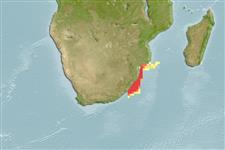Klassifizierung / Names
Namen | Synonyme | Catalog of Fishes(Gattung, Arten) | ITIS | CoL | WoRMS | Cloffa
Elasmobranchii (Haie und Rochen) (sharks and rays) >
Carcharhiniformes (Ground sharks) >
Pentanchidae (Deepwater catsharks)
Etymology: Holohalaelurus: holos (Gr.), whole or entire, i.e., being a form of Halaeurus without any labial folds or grooves in the mouth. (See ETYFish); favus: Latin for honeycomb, referring to the color pattern of fresh specimens. (See ETYFish).
Environment: milieu / climate zone / depth range / distribution range
Ökologie
seewasser; tiefenbereich 200 - 1000 m (Ref. 75585). Subtropical
Western Indian Ocean: South Africa.
Size / Gewicht / Alter
Maturity: Lm ? range ? - ? cm
Max length : 51.5 cm TL Männchen/unbestimmt; (Ref. 75585); max. veröff. Gewicht: 301.30 g (Ref. 75585)
Kurzbeschreibung
Morphologie | Morphometrie
This relatively large species is distinguished by the following characters: denticles on dorsal midline greatly enlarged from snout to second dorsal origin; denticles on pectoral fin dorsal surface greatly enlarged in adults; no club-shaped papillae on the distal tip of the clasper; buccal papillae in mouth large and prominent on upper and lower surfaces; moderate vertebral count, 124 total vertebrae in the holotype (123 total in paratype, mean 117.8); relatively high tooth counts, 65 total upper teeth in the holotype (66 in the paratype, mean 66.3), 70 total lower teeth in the holotype (58 in paratype, mean 60.3); covered in irregularly shaped spots and reticulations on a brown background, resembling a honeycomb pattern; white spots rarely present, if present, are inconspicuous (Ref. 75585).
Life cycle and mating behavior
Geschlechtsreife | Fortpflanzung | Ablaichen | Eier | Fecundity | Larven
Human, B.A., 2006. A taxonomic revision of the catshark genus Holohalaelurus Fowler 1934 (Chondrichthyes: Carcharhiniformes: Scyliorhinidae), with descriptions of two new species. Zootaxa 1315:1-56. (Ref. 75585)
IUCN Rote Liste Status (Ref. 130435)
Bedrohung für Menschen
Harmless
Nutzung durch Menschen
Mehr Information
NamenSynonymeMetabolismusRäuberÖkotoxikologieFortpflanzungGeschlechtsreifeAblaichenSpawning aggregationFecundityEierEientwicklung
Alter/GrößeWachstumLänge-GewichtLänge-LängeLängenhäufigkeitenMorphometrieMorphologieLarvenLarven Pop.Dyn.RekrutierungDichteBRUVS
ReferenzenAquakulturAquakultur ProfilZuchtlinienGenetikElectrophoresesVererbbarkeitKrankheitenVerarbeitungNutrientsMass conversion
PartnerBilderStamps, Coins Misc.LauteCiguateraGeschwindigkeitSchwimmstilKiemenoberflächeOtolithsGehirngrößeSehfähigkeit
Tools
Zusatzinformationen
Download XML
Internet Quellen
Estimates based on models
Preferred temperature (Ref.
123201): 11.3 - 12.4, mean 11.4 °C (based on 6 cells).
Phylogenetic diversity index (Ref.
82804): PD
50 = 0.5312 [Uniqueness, from 0.5 = low to 2.0 = high].
Bayesian length-weight: a=0.00355 (0.00176 - 0.00714), b=3.09 (2.91 - 3.27), in cm total length, based on LWR estimates for this (Sub)family-body shape (Ref.
93245).
Trophic level (Ref.
69278): 4.2 ±0.6 se; based on size and trophs of closest relatives
Widerstandsfähigkeit (Ref.
120179): niedrig, Verdopplung der Population dauert 4,5 - 14 Jahre. (Preliminary low fecundity).
Fishing Vulnerability (Ref.
59153): Moderate vulnerability (41 of 100).
